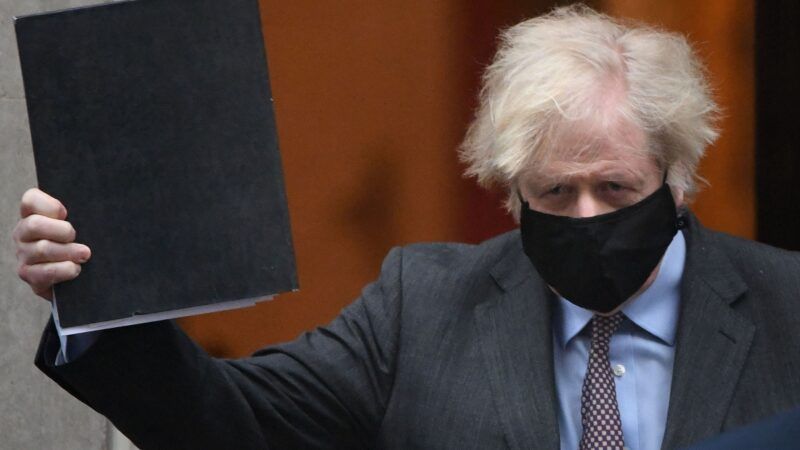Despite Starkly Different COVID-19 Policies, the U.S. and the U.K. Saw Similar Drops in Cases Around the Same Time
The same is true of Texas and California, which suggests that legal restrictions are not as important as politicians imagine.

Newly identified COVID-19 cases have fallen dramatically in both the United States and the United Kingdom since early-to-mid January, notwithstanding strikingly different government policies aimed at controlling the pandemic. The comparison casts further doubt on the assumption that broad legal restrictions play a crucial role in reducing virus transmission.
Despite the lockdowns that all but a few governors imposed last spring, the United States has seen more COVID-19 deaths per capita than the vast majority of countries. But it still has fared better than several European countries that imposed wider and more prolonged legal restrictions. The countries with higher death rates include the U.K, which has gone through several rounds of national lockdowns.
In early November, the Prime Minister Boris Johnson responded to surging infections with a new lockdown that closed most businesses, banned indoor gatherings of two or more people from different households, and required everyone to stay home without a "reasonable excuse." The rules were loosened in early December, then tightened again the week before Christmas. While the United States also saw a big increase in daily new cases in the fall and winter, it did not lead to anything like the nationwide lockdown imposed in the U.K., although some states did tighten their restrictions on social and economic activity.
Despite the stark difference in policy, both countries saw remarkably similar COVID-19 trends this winter. According to Worldometer's numbers, the seven-day average of new cases peaked in the U.K. on January 9; it peaked in the U.S. two days later. That number then fell sharply in both countries. As of yesterday, it was down 81 percent in the U.K. and 73 percent in the U.S.
Daily deaths are also falling in both countries. As of yesterday, the seven-day average in the U.K. was down 61 percent from the peak on January 23. In the U.S., it was down 43 percent from the peak on January 26. Given the dramatic drop in daily new cases that began more than a month ago, daily deaths should continue to fall.
"British experts attribute the decline to a strict national lockdown," The New York Times reports. "Vaccines don't explain it: Even though a quarter of the population has been vaccinated, only the earliest recipients had significant protection by Jan. 10, when cases there started to drop. Those early doses mostly went to health-care workers and elderly patients already in the hospital."
What about the United States? "Although the United States did not impose a national lockdown, voluntary changes in behavior, along with some degree of immunity in hard-hit communities, may have helped prevent an even worse outcome after the holidays," the Times says, citing Johns Hopkins epidemiologist Caitlin Rivers. "During the winter, when things were getting really bad, I think people saw how bad things were getting in their community and made different choices," Rivers told the Times. "They canceled gatherings, they stayed home more, they reached for the mask, and those things really do help, put together, to reduce transmission."
Here in the United States, Rivers thinks voluntary precautions were largely responsible for reversing the upward trends in cases and deaths. Yet in the U.K., according to the Times, "British experts" are crediting the government's decisive action. While Americans chose to be more cautious, in other words, Brits had to be forced. The premise that U.K. residents are more reckless than Americans and less inclined to comply with COVID-19 safeguards seems implausible, although it is convenient for lockdown enthusiasts.
The same story of starkly different policies and similar outcomes emerges from a comparison of Texas and California, the two most populous states. While California Gov. Gavin Newsom ordered a new lockdown on December 3, Texas Gov. Greg Abbott did not impose new restrictions, and the state remained largely open. Yet since mid-January, the two states have seen almost the same drop in the seven-day average of newly reported cases, which has fallen by 85 percent in California and 81 percent in Texas.
Notwithstanding its much stricter regulations, California saw a bigger increase in new infections during December and January, when the seven-day average tripled. In Texas during the same period, the average doubled. Nationwide in the United States, the average rose 50 percent. In the U.K., it quadrupled.
Since politicians are more inclined to impose restrictions when they see infections rising dramatically, it is not surprising that Johnson and Newsom decided new lockdowns were necessary. But on the face of it, those policies, despite the economic and social costs they entailed, were not actually necessary to bring case numbers back down. Since jurisdictions that took a much looser approach saw similar declines around the same time, it seems official commands do not play as important a role in reducing the spread of COVID-19 as many politicians imagine.


Show Comments (95)